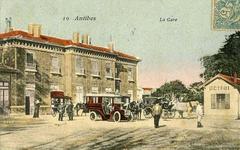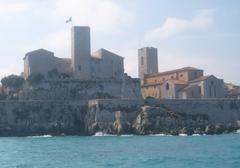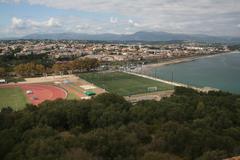Visiting Hours, Tickets, and Historical Insights of Musée national Fernand Léger, Antibes, France
Date: 24/07/2024
Introduction
The Musée national Fernand Léger, located in Biot near Antibes, France, stands as a beacon of modern art and a testament to the visionary artist Fernand Léger. Established in 1960, five years after Léger’s death, the museum was conceived by his widow, Nadia Léger, and his close collaborator, Georges Bauquier, to honor his extensive body of work. Fernand Léger, a pioneer of Cubism and a central figure in 20th-century art, sought to integrate art into everyday life, a vision that the museum continues to uphold (source).
Architecturally designed by André Svetchine, with a park by Henri Fisch, the museum’s striking façade features an immense mosaic originally intended for the Hanover stadium, embodying Léger’s vibrant and geometric artistic style (source). Over the years, the museum has expanded and modernized, enhancing its exhibition spaces and visitor experience. It houses the largest collection of Léger’s works globally, spanning his neo-Impressionist beginnings to his Cubist masterpieces and contributions to decorative and monumental art (source).
With a rich program of exhibitions, educational workshops, and cultural events, the Musée national Fernand Léger is not just a repository of art but a dynamic cultural institution. It offers a comprehensive and engaging experience, attracting art enthusiasts and tourists alike to explore the legacy of Fernand Léger and the broader context of modern art (source).
Table of Contents
- [Origins and Establishment](#origins-and-establishmentorigins-and-establishment)
- [Inauguration and Early Years](#inauguration-and-early-yearsinauguration-and-early-years)
- [Donation to the State](#donation-to-the-statedonation-to-the-state)
- [Modernization and Expansion](#modernization-and-expansionmodernization-and-expansion)
- [Significance and Cultural Impact](#significance-and-cultural-impactsignificance-and-cultural-impact)
- [Visitor Information](#visitor-informationvisitor-information)
- [Tickets and Visiting Hours](#tickets-and-visiting-hourstickets-and-visiting-hours)
- [Accessibility](#accessibilityaccessibility)
- [Travel Tips](#travel-tipstravel-tips)
- [Visitor Experience](#visitor-experiencevisitor-experience)
- [FAQ](#faqfaq)
- [Conclusion](#conclusionconclusion)
Origins and Establishment
In 1955, Fernand Léger, a prominent 20th-century artist, acquired the Mas Saint-André, a villa located at the foot of the village of Biot in the Alpes-Maritimes region of southeastern France. Léger intended to install polychrome ceramic sculptures in the garden of this property. Unfortunately, he passed away shortly after acquiring the villa. His widow, Nadia Léger, and his close collaborator, Georges Bauquier, decided to honor his legacy by creating a museum dedicated to his work on this site (source).
The museum project was designed by architect André Svetchine, with the landscape architect Henri Fisch entrusted with the design of the park. The façade of the building features an immense mosaic initially planned by Léger for the Hanover stadium but never realized (source).
Inauguration and Early Years
The Fernand Léger Museum was inaugurated on the evening of May 13, 1960. This event was a significant cultural milestone, attracting over five thousand guests, including celebrities from the literary and artistic worlds, film stars, and political representatives. The inauguration was held under the patronage of renowned artists such as Picasso, Braque, and Chagall (source).
The museum’s opening marked the establishment of the first monographic museum in the region, setting a precedent for other modern art projects in the vicinity, such as the Maeght Foundation in Saint-Paul in 1964 and the Marc Chagall Museum in Nice in 1969 (source).
Donation to the State
In 1969, Nadia Léger and Georges Bauquier donated the museum building, the land, and a rich collection of over three hundred works to the French State. This donation was formalized during an official event attended by André Malraux, the then Minister of Culture. The museum was subsequently designated as a national museum, with the founders remaining as directors for life (source).
Modernization and Expansion
Between 1987 and 1990, the museum underwent significant expansion. Architect Bernard Schoebel was commissioned by the Ministry of Culture to design a new wing, effectively doubling the exhibition space. The new building’s east and west facades feature monumental mosaics based on Léger’s plans for La Triennale di Milano (1951) and the University of Caracas (1954), executed by Heidi Melano (source).
Further modernization efforts took place between 2004 and 2008. Architect Marc Barani was tasked with restructuring the exhibition spaces and improving public reception. The furniture was designed by Eric Benqué, and the garden was redesigned by landscape architect Philippe Déliau. These renovations aimed to enhance the presentation of the permanent collection and improve the overall visitor experience (source).
Significance and Cultural Impact
The Musée national Fernand Léger holds a unique place in the cultural landscape of the French Riviera. It is the only museum in the world dedicated exclusively to Fernand Léger, showcasing over 450 works by the artist. The museum’s collection spans Léger’s entire career, from his neo-Impressionist beginnings to his Cubist successes and his later works in decorative and monumental art (source).
The museum also plays a crucial role in promoting Léger’s vision of social art accessible to all. His abstract, colorful ceramic mural compositions for architectural projects, many of which were interrupted by his death, are a testament to his commitment to integrating art into everyday life (source).
Visitor Information
Tickets and Visiting Hours
- Opening Hours: The museum is open every day except Tuesdays, January 1, May 1, and December 25.
- Visiting Hours: Typically, the museum operates from 10:00 AM to 6:00 PM, but it is advisable to check the official website for any changes in opening hours.
- Tickets: Admission is free for under-26s, the disabled, and everyone on the first Sunday of the month. Regular ticket prices and any special discounts can be found on the official website.
Accessibility
The museum is accessible to people with reduced mobility and offers family workshops for a child-friendly experience.
Travel Tips
- Location: Situated in Biot, the museum is conveniently located near other historical sites and attractions in the French Riviera. It is a perfect stop for those exploring the region.
- Nearby Attractions: Visitors may also want to explore the Maeght Foundation in Saint-Paul and the Marc Chagall Museum in Nice.
Visitor Experience
The museum offers a rich program of exhibitions, conferences, film screenings, and educational workshops throughout the year. Visitors can explore the evolution of Léger’s style and gain insights into lesser-known aspects of his work, such as his contributions to decorative and monumental art. The museum also features a pleasant garden with Mediterranean trees and sculptures based on Léger’s studies (source).
FAQ
Q: What are the Musée national Fernand Léger visiting hours? A: The museum is typically open from 10:00 AM to 6:00 PM, but it is closed on Tuesdays, January 1, May 1, and December 25.
Q: How much are the tickets for the Musée national Fernand Léger? A: Admission is free for under-26s, the disabled, and everyone on the first Sunday of the month. Regular ticket prices can be found on the official website.
Q: Is the museum accessible for people with disabilities? A: Yes, the museum is accessible to people with reduced mobility and offers family workshops for a child-friendly experience.
Conclusion
The Musée national Fernand Léger stands as a testament to the enduring legacy of Fernand Léger and his contributions to modern art. Its rich history, significant cultural impact, and commitment to accessibility make it a must-visit destination for art enthusiasts and tourists alike. The museum continues to honor Léger’s vision, offering a comprehensive and engaging experience for all visitors.
For more information, download the mobile app Audiala, check out other related posts, or follow us on social media for the latest updates.
References
- Musée national Fernand Léger, History, Fernand Léger National Museum. https://musees-nationaux-alpesmaritimes.fr/fleger/en/history-fernand-leger-national-museum.
- Wikipedia, Fernand Léger National Museum. https://en.wikipedia.org/wiki/Fernand_Léger_National_Museum.
- Explore Nice Côte d’Azur, Musée National Fernand Léger. https://www.explorenicecotedazur.com/en/info/musee-national-fernand-leger-en/.
- Provence Lovers, Visit Museum Fernand Léger Antibes. https://provencelovers.fr/en/visit-museum-fernand-leger-antibes/.
- Grand Palais, Biot, Léger and New Realists take over the walls. https://www.grandpalais.fr/en/article/biot-leger-and-new-realists-take-over-walls-fernand-leger-national-museum



